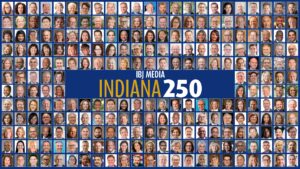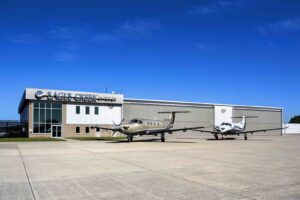This article is re-posted with permission by Flight Levels Online. The story highlights how Eagle Creek CEO Matt Hagans helped John Swift find and purchase his Twin Commander 690B.
They say print is dead. Clearly they haven’t met John Swift.

Swift is the third-generation owner of the John S. Swift Co., a multiservice printing company located outside Chicago, with offices and operations around the world. The company was started in 1912 by Swift’s grandfather. His father took over earlier in the twentieth century, and Swift has been at the helm since 1975. Swift has presided over a company in an industry that has changed more in the last 20 years than it had in the previous 300. In that time publishing has gone from quintessential Manhattan three-martini lunches to a lean global manufacturing business where only the strong survive.
Swift said that his company thrives in part because it has a strong niche. “We have a strong binding business,” he said. “Once you get a niche the customers come to you.” Swift Co. prints and binds everything from magazines and books to catalogs and—no kidding—phone books. Central to the company’s history, its success, and Swift’s ability to quickly and easily visit clients, employees, and vendors, is its embrace of aviation.

The aviation connection began early. Swift’s grandfather was an avid pilot and owned a sister aircraft to the Spirit of St. Louis. Swift’s own love affair with aviation began on a business trip to South Africa. There he took his first flight, and he was instantly hooked. “Once bitten by the bug you can’t get enough of that stuff,” he said. Although Swift said his father was more numbers-focused and aviation didn’t appeal to him, he saw the logic in using aircraft to further the business. First there was a Beechcraft Bonanza, then a pressurized Baron. Swift called it a “maintenance nightmare.” As is the case with many Baron owners moving up, the next aircraft was a King Air. Then three more.
When Swift’s father retired from the company the rest of the family pulled back on aviation, so Swift bought another Baron to stay active. But he missed turbines. That’s when a flyer arrived in the mail from Eagle Creek Aviation Services explaining the virtues of the Twin Commander. “I thought 315 knots true was a typo,” he said. He called, and ECAS’ Matt Hagans eventually got Swift into a 690B.

Later, a 695B Model 1000 came up for sale. It was the second-to-last ever built. “When I first saw it I thought it was tired and run out,” he said. “Matt told me ‘When you get it back from us you’ll be amazed.’ What a ship it was!” Since then Swift has taken the aircraft all over North America, South America, the Caribbean, and Europe. He’s completed two hot-section inspections, and is anticipating needing a third soon. All told, Swift estimates he has 6,000 or 7,000 hours in the Twin Commander, a massive amount of experience for an owner-operator.
No compromises
It seems that with aircraft we are always making some sort of compromise. Maybe the airplane is fast, but the range is limited. Or the range is sufficient but to get the range you can only carry you and the family dog. Or maybe the airplane is good but the entire support network consists of two guys in a rented office somewhere who never answer the phone and can’t help even if they do. Despite having the means to move to a jet, Swift has stayed with his Twin Commander because he sees the airplane as one without compromise. “We call it the family station wagon,” he said. “It will go anywhere, anytime.” He continues to be impressed with the speed, load-carrying ability, range, operating costs, reliability, and support.

For someone who flies his airplane all over the western hemisphere it can be hard to pin down a “normal” trip. But if Swift has one, it’s from his home airport in Schaumburg, Illinois, to Miami Executive Airport (previously the Kendall-Tamiami Executive Airport). He typically flies the 1,000-plus miles in fewer than four hours, getting from his home to a vacation home in Key Largo or business in Miami in significantly less time than the airlines could do it.
But for Swift the real benefit is the joy of flying. It’s why he has decided to fly himself to Venezuela, and various places in Central America, and about five times back and forth to Europe. “Sure I could jump on Emirates and fly over there,” he said. But he loves the flying. “It’s like Zen. They are just fun to fly. I can’t get enough of them.”
For someone who flies multiple trips a week, dispatch reliability and support are critical. Swift’s recommendation for finding success with a legacy airframe is to take care of it. “If you take care of something it will take care of you,” he said. “Do all your inspections and keep current and the plane will fly, fly, fly.” For that reason he gets all his maintenance and inspections performed at a Twin Commander Authorized Service Center. And although he’s partial to a few that are closer to home, he also likes to drop in on locations he’s never been to before. “It’s nice to have a variety of eyes on it.”
Over the years Swift has had a few maintenance hiccups, including on the ramp in Rochester, Minnesota. In the winter. Thanks to a phone call to a service center and a lucky hammer he was able to diagnose the problem and get airborne with only a slight delay. It’s that robustness and support network that he relies on to get him all over the world.

At more than 100 years old, the John S. Swift Co. continues to thrive in a highly competitive environment. With a combination of modern technology, a range of offerings, and a strong niche, Swift has found success in a changing world. But much of the company’s success is due to old-fashioned face-to-face meetings, presentations, and networking. Something made possible by a Twin Commander.





